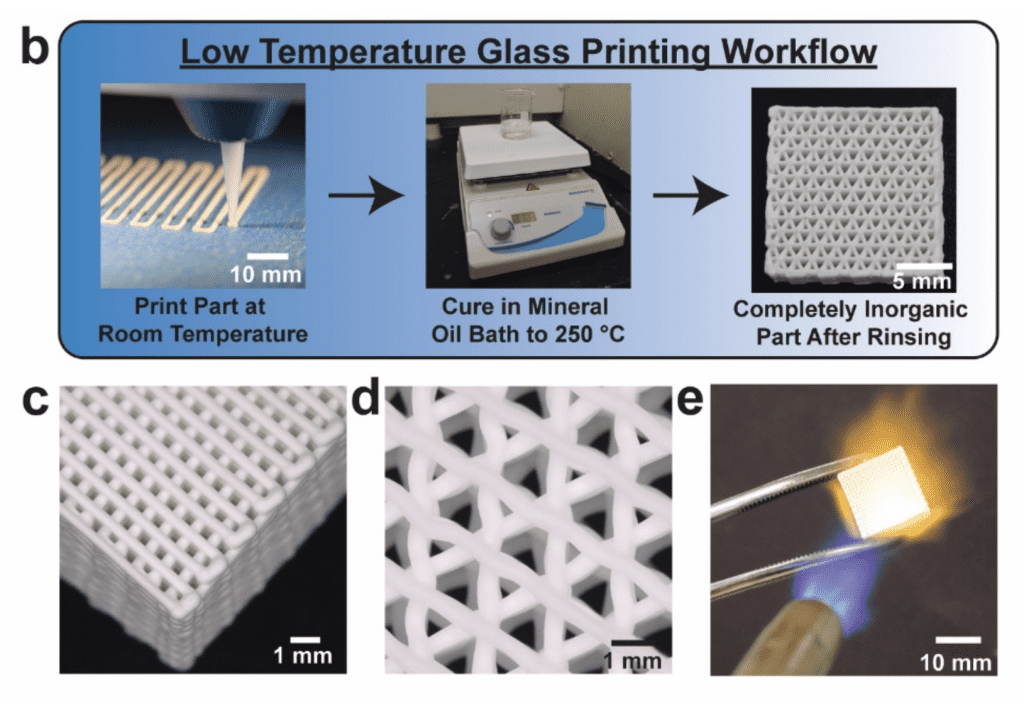Researchers at the US Department of Defense-backed MIT Lincoln Laboratory have come up with a novel low-temperature approach to 3D printing glass objects.
More from the News
Unlike conventional glass 3D printing and post-processing, which involves exposing parts to temperatures of 1,000 °C or more, the scientists’ involves layering a custom, highly-filled ink, that’s curable at 250°C. Due to the accessibility of their material’s ingredients and the simplicity of their process, the team believe it could “facilitate the widespread production of glass objects,” with unique characteristics.
“We have shown a modular system that can be tuned to print a wide variety of inorganic glasses with embedded functional nanomaterials (dielectric, metallic and optical),” explain the scientists in their paper. “We envision this versatile materials platform, when combined with multi-material additive manufacturing, will enable the fabrication of a wide variety of robust microsystems.”
Glass 3D printing’s thermal problem?
Though glass 3D printing remains at a relatively early stage of development, the technology is beginning to show potential as a means of realizing objects with more complex geometries than those possible via traditional glass processing.
Using multi-material techniques, for instance, researchers are increasingly able to create parts like optical lenses and microfluidic devices with higher mechanical strength and graded refractive indices. Given the sub-millimeter features it’s now possible to achieve using 3D printing, the technology’s also showing potential as a means of producing glass objects capable of enhancing devices’ functionalities.
That being said, such parts, when created via stereolithography, two-photon lithography or direct ink writing (DIW), are subjected to high temperatures, whether this be in deposition or during debinding. These steps tend to yield stable glass structures, but also require the use of specialized refractory gear, and they can be incompatible with thermally-sensitive materials, limiting users’ choice of feedstock.
“Emerging techniques for additively generating inorganic structures have the potential to disrupt the ceramic and glass industries,” say the team in their paper. “Glass offers advantages over other additive manufacturing materials, such as improved biocompatibility and enhanced thermal stability. However, current methods for producing glass require elevated temperatures to produce a completely inorganic part.”

The MIT low-temp alternative
Central to the researchers’ alternative, is a custom nano-composite they’ve developed. Composed of functional nanoparticles embedded in a sodium silicate solution, as well as silver particles in its conductive iteration, the ink is printable at much lower temperatures than normal. Once formulated, this material was put into action by the team via a DIW-equipped 3-axis Aerotech gantry system.
After creating some basic shapes and structures, the scientists found that mounting barrels of structural and silver inks onto the machine’s two independent z-axes, enabled the creation of capacitors and resistors. These parts, following curing in a mineral oil bath, showed a high level of stability, though the MIT team admit that they didn’t quite have the same optical clarity as sintered parts.
Through later imaging, the researchers also found they’d been able to achieve different trace lengths with their prototype resistors, and tweak the permittivity levels of their material to change the capacity of capacitors produced, with those made from barium, strontium and titanium oxide having the highest power factor.
According to the team, their experiments show that their process can be tailored to produce a “broad range of electronic materials and integrated microsystems.” Moving forwards, the scientists plan to focus on improving the optical clarity of parts produced, and providing them with graded properties, as a way of further broadening their potential applications.
“The major advantage of this technique lies in its simplicity,” conclude the team in their paper. “We believe this silicate-based strategy will facilitate the production of custom microfluidic chemical reactors with much wider chemical and thermal compatibilities than are currently available. Furthermore, we predict these materials will allow for the creation of novel, high power radio frequency devices.”

Putting glass 3D printing into practise
Glass 3D printing may not have been commercialized just yet, but the technology continues to find new applications, many of which have focused on photonics. As one of the leading start-ups working in this emerging field, Glassomer has come up with a 3D printing silica nanocomposite of its own, which has since been 3D printed at room temperature into glass parts, the thickness of a human hair.
The researchers’ findings are detailed in their paper titled “Low Temperature Additive Manufacturing of Glass,” co-authored by Bradley Duncan, Devon Beck, Paul Miller, Ryan Benz and Melissa Smith.
Subscribe to AM Chronicle Newsletter to stay connected: https://bit.ly/3fBZ1mP
Follow us on LinkedIn: https://bit.ly/3IjhrFq
Visit for more interesting content on additive manufacturing: https://amchronicle.com/
For more information and case studies on metal additive manufacturing register for metal additive manufacturing symposium : https://amchronicle.com/metal-additive-manufacturing/


